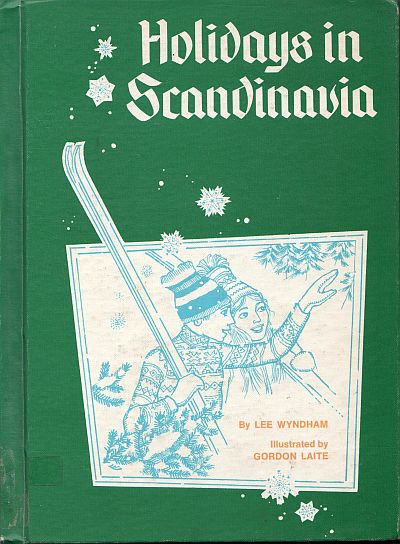 tek's rating:
tek's rating:  ¼
¼
Holidays in Scandinavia, by Lee Wyndham (pub. 1975)
Amazon; B&N; Goodreads; StoryGraph
This is a children's book, published the year I was born. I think it must have been in the late 2000s or early 2010s that I bought this used copy, which I think I found at a bank that was having a book sale, for some reason. Anyway, I picked it up because I'm of Swedish descent, and Swedish traditions have always been celebrated in my home town of New Sweden, Maine. I got around to reading it over December 23-25, 2017. But Christmas is only one of the holidays described in the book; it actually takes place over the course of a year.
1. The Vasalopp
(Or as Wikipedia calls it, Vasaloppet.) It's an annual ski race that takes place on the first Sunday of March, in Sweden.
2. Norway's Homenkollen Day
Another ski festival, taking place in March.
3. A Sun Pageant in Norway
This is about Soldag (or "Sun Day"), which celebrates the end of the long winter nights.
4. The Lenten Season in Scandinavia
This chapter talks about how Lent is observed in Sweden, Norway, and Denmark. It also has a subsection about "Easter Witches," and one about Easter eggs. The book says that in Sweden, hardboiled eggs are dyed for Easter (which is what I suppose most people do here in the US), but it mentions children in Norway blowing the contents of raw eggs out through a small hole... which is something I remember doing in school once, probably in first or second grade. It seems odd to me that my school would have done a Norwegian tradition instead of a Swedish one, but whatever. The rest of the chapter is about Easter Day in Scandinavia.
5. Sweden's Walpurgis Eve
This takes place on May 1 (or the night before), and celebrates the arrival of spring.
6. Constitution Day in Norway
This occurs on May 17, commemorating the signing of the Norwegian Constitution.
7. The Birthday of the Danish Flag.
June 15th is the day in 1219 when Danish king Valedmar II and his army defeated the Estonian army, supposedly after a flag (called "Dannebrog") fell from Heaven to give the Danish soldiers renewed hope, or whatever.
8. Midsummer in the Land of the Midnight Sun
This chapter talks about celebrations on June 23 in Norway (Jonsok) and Denmark (Sankt Hans Aften), and on the nearest Saturday to June 24 in Sweden (Midsommar). This one is kind of familiar to me, because Midsommar is always celebrated here in New Sweden, with a Maypole, and children doing Swedish dances, and whatnot.
9. The Christmas Season in Scandinavia
This chapter's sections include Advent, and Lucia's Day in Sweden (which was celebrated in my elementary school), and "Christmas Preparations," and "The Christmas Tree," and Julafton (Christmas Eve), and Jultomten (a gnomish mythological creature which I'm sure I heard of when I was a kid, though he was just called "Tomte," which is the Swedish equivalent of Santa Claus), and a drink called glög (we sometimes have the non-alcoholic kind), and "Christmas in the Country."
10. The New Year in Scandinavia
This chapter has different sections for how the holiday is celebrated in Denmark, Norway, and Sweden. The final section is about St. Knut's Day (January 13), which is the end of the Yule season.
Well, after that, the book has a pronunciation guide for various foreign words. Anyway, I guess I haven't said much about any of these holidays. The book describes each of them at some length (along with illustrations), though I'm not sure it's 100% accurate about all the things it says (or how it spells some things). On the whole, I thought it was reasonably interesting, even if it was written for children. (Nowadays, of course, you can just Google any subject you're interested in, to find both scholarly accounts and personal accounts of how people celebrate these various holidays.) But I did find the book somewhat nostalgic, or whatever.